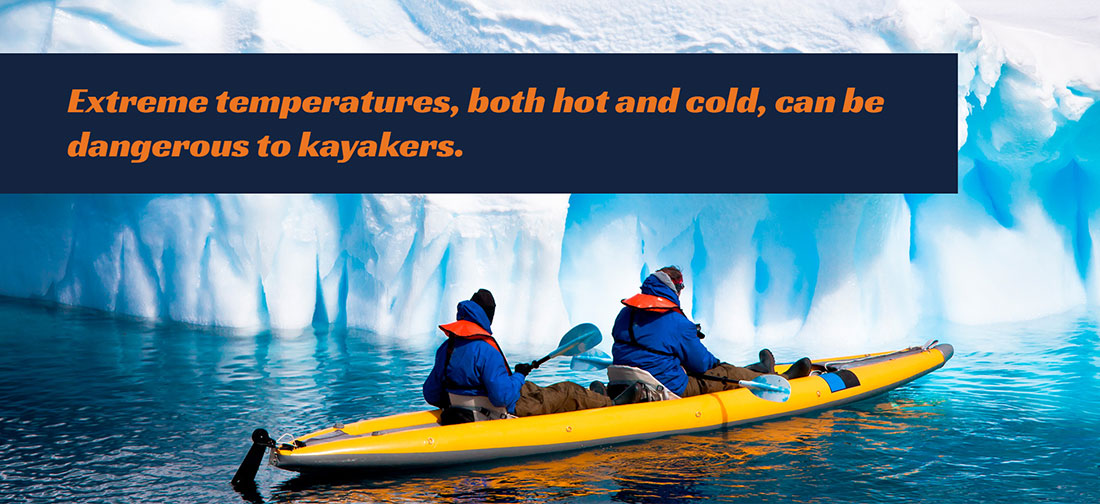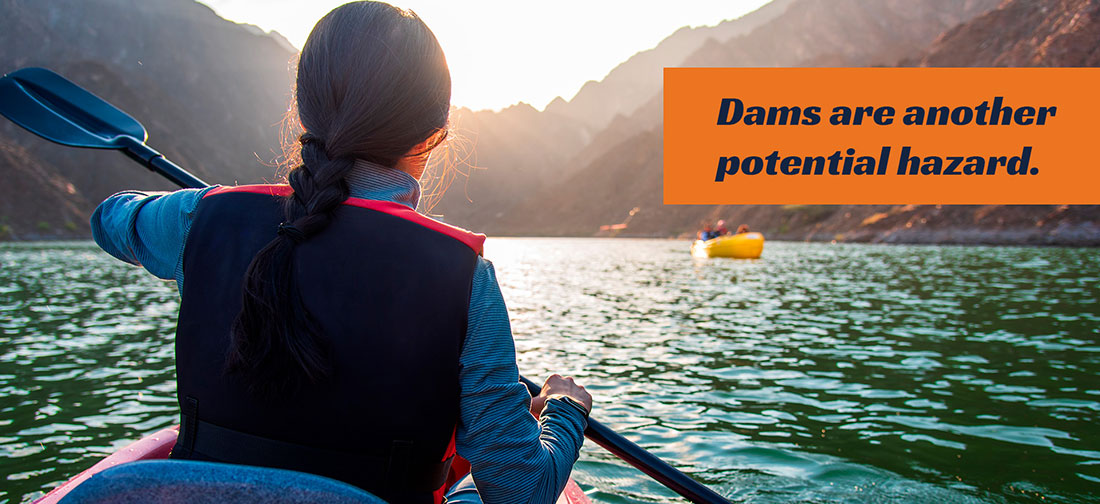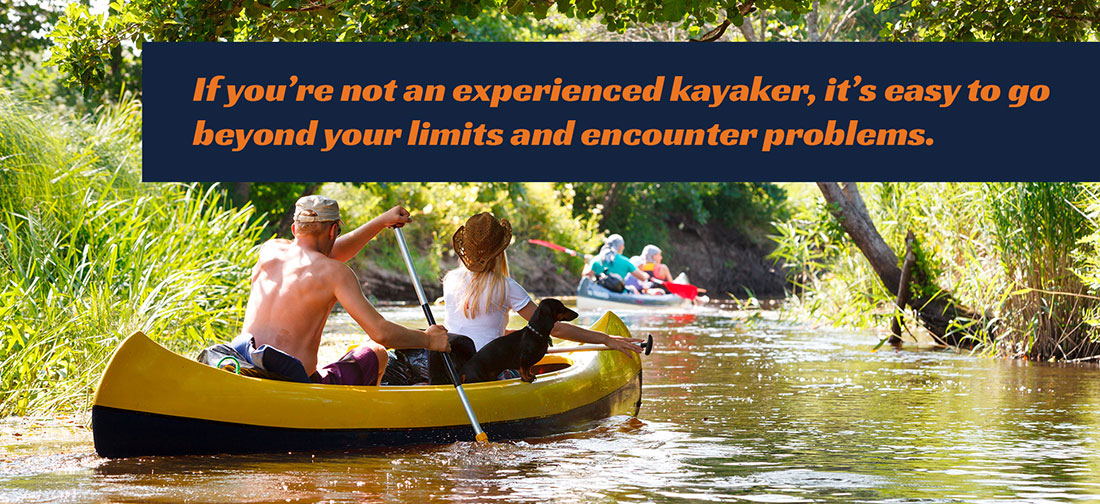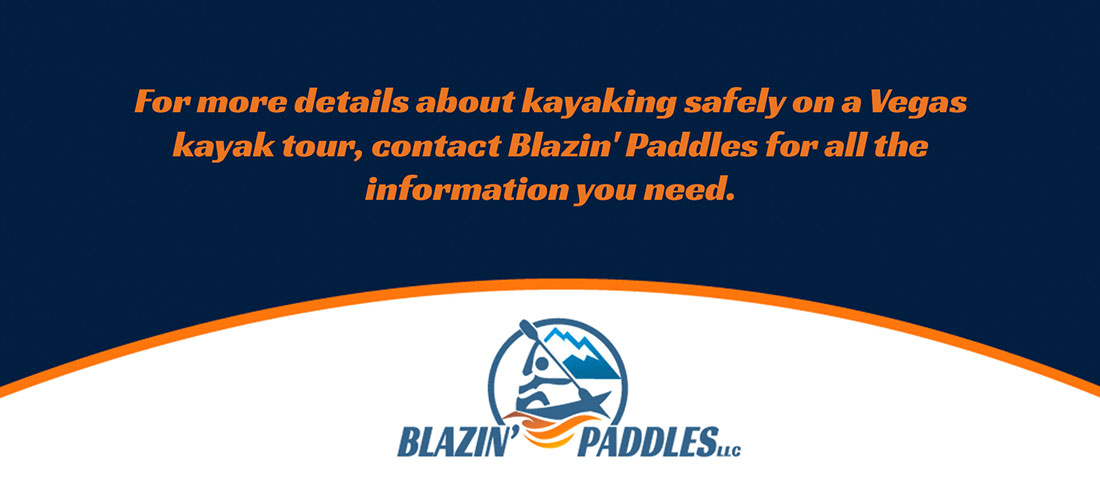When should you not go kayaking?
Posted on: January 24th, 2023
As with many sports and outdoor activities, some risks are associated with kayaking in Vegas. However, many potential risks can be avoided by using common sense, being prepared physically for kayaking, and avoiding kayaking when it’s unsafe to go out. The Blazin’ Paddles staff will gladly assist if you have questions about safety before your kayaking tours in Vegas or before boating solo.
Kayaking Risks
Hazards associated with kayaking can stem from several sources. The most common problems kayakers encounter include the following:
Hypothermia and heatstroke Getting lost Not being visible Dams Alcohol Inexperience Capsizing Wildlife
Extreme temperatures, both hot and cold, can be dangerous to kayakers. Before heading out on a Las Vegas kayak trip for the day, check the weather. You will want to pack suitable clothing and accessories for the air and water temperatures, which can be quite different. If the air temperatures are forecast to fluctuate, wear or pack clothing to cover the range of temperatures. Water temperatures can be colder than air temperatures, and you can develop hypothermia if you fall into the water within just a few minutes. If you do fall out of the boat or end up in cold water, remember the “1-10-1” rule, which is that it takes one minute after falling in to recover your breathing, 10 minutes to perform a self-rescue, and one hour before you lose consciousness because of hypothermia. In that hour, you can also lose the ability to move your muscles. Exhaustion and confusion can also set in. In addition to temperature, look at the forecasted winds and precipitation for the day you plan to go out so that you can stay warm or cool, dry, and comfortable. You may also encounter hot and sunny weather, as Las Vegas has over 200 sunny days each year, on average. On days with heat in the forecast, bring extra water and avoid overexertion. Heat stroke and heat exhaustion are two heat-related conditions that can affect people on kayak tours in Vegas. If you are prone to heat illness, you may want to go for a shorter kayak outing that day or try to avoid being out in the middle of the day when temperatures are warmest.
Getting lost, which can result in being stranded without food, water, and other essential provisions is another potential problem for kayakers. If you’re kayaking in unfamiliar territory or are not experienced, it is safest to go kayaking with a group. Aside from not knowing the local landmarks, kayaking in an area you are unfamiliar with can be dangerous because you don’t know the water you will be kayaking, either. Certain places, such as the ocean, can have their own unique hazards. The weather can change rapidly and unexpectedly on open water, which can leave you disoriented and unable to get back to shore. The wind can pick up too, which can make you tired faster. Even if you know the area and you’re an experienced kayaker, problems can still arise during your outing. Therefore, it’s a good idea to bring a cell phone or another type of communication device and let people know your itinerary. If you are visiting the Las Vegas area and don’t know where to go kayaking, check out the Las Vegas kayak tours offered by Blazin’ Paddles, which have optimal distances and lengths for everyone.
Some kayaking accidents occur when kayakers are not visible to other boaters. If you will be traveling at dawn, dusk, or in other conditions when visibility is poor, wear lights or put them on your boat for safety. Aside from a safety issue, having lights on your kayak is also required by law. The US Coast Guard requires all kayakers to have a white light visible from all angles. The light must be on the boat from dusk to dawn, but it is also not a bad idea to have light during daylight hours. You can also practice other safety measures for kayaking in high-traffic boat areas, such as staying as close to the shore as possible and wearing a personal flotation device (PFD). Wearing reflective clothing in addition to a kayak light is highly recommended.
Dams are another potential hazard. Dams are manmade structures that can be hazardous to kayakers. Dams are usually difficult to see, not appropriately marked, and may be hidden, which means you can arrive at a dam before you know it’s there and have time to react. Dams can also be full of debris, which is just as hazardous. Another hazard of dams is the way that the water moves around them. The water near dams generally pulls down or moves in a washing machine style. The downward and circular motion of the water can prevent kayakers from escaping to safety, even if they are wearing a PFD. If you come across a dam, try to get to shore before you reach the dam. Never try to kayak over a dam.
Alcohol and kayaking are two activities that don’t mix. While it’s easy (and often tempting) to consider a kayaking adventure as a good time to party, don’t get into or back in the boat after you’ve been drinking. In drownings associated with kayaking, nearly 70% of all victims are found to have alcohol in their blood. Alcohol is also attributed to almost 25% of all fatal kayaking accidents. Along with simply being a safety issue, kayaking under the influence is a federal offense. That applies to other substances, too, including recreational drugs and some medications.
If you’re not an experienced kayaker, it’s easy to go beyond your limits and encounter problems. People may set out on a kayaking trip, such as a Hoover Dam kayak tour, without having the basic fitness and boating experience they need to safely and confidently complete the trip. You may become tired if you kayak longer distances or in more challenging water than you’re used to. Furthermore, you might find yourself in treacherous conditions and lack the safety knowledge required to get out of harm’s way. No matter where you plan to go boating, keep the simple philosophy in mind that you should always plan a kayaking route that is within your capabilities. If you want to go kayaking, but you don’t know much about the place you’re going, try talking to the local paddlers first or search for an interactive map of local conditions. Checking the winds, air and water temperatures, tides, currents, and other factors can help you determine whether a kayaking spot is safe.
Capsizing is another potential safety problem that can affect kayaking tours in Vegas. Kayakers all say that capsizing happens so often, it’s not a matter of “if” it will happen to you, but when. Even if you’re out paddling on calm waters on a sunny day, you can still run the risk of capsizing. Therefore, kayakers should be prepared to help themselves. Wearing a PFD and learning a self-rescue technique, which entails staying calm, is helpful. Call for help if others are within earshot, or use an emergency communication device to notify authorities.
Wildlife can also be hazardous on a Las Vegas kayak outing. Wildlife encounters can range from smaller, pesky animals such as birds and beavers to dangerous animals like snakes or bears. Keeping a safe distance from animals and paddling away if one appears aggressive can spare you from a wildlife attack.
For more details about kayaking safely on a Vegas kayak tour, contact Blazin’ Paddles for all the information you need.




